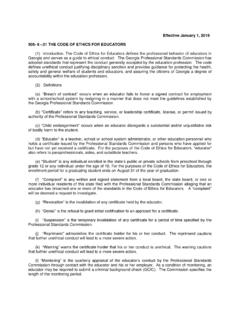Transcription of Ref. Ares(2014)968076 - 28/03/2014
1 Ref. Ares(2014)968076 - 28/03/2014 . EUROPEAN COMMISSION. HEALTH AND CONSUMERS DIRECTORATE-GENERAL. Public Health and Risk Assessment Medicinal Product quality, safety and efficacy Brussels, 16 August 2013. EudraLex The rules Governing Medicinal Products in the European Union Volume 4. EU Guidelines for Good Manufacturing Practice for Medicinal Products for Human and Veterinary Use Part 1. chapter 2: personnel Legal basis for publishing the detailed guidelines: Article 47 of Directive 2001/83/EC on the Community code relating to medicinal products for human use and Article 51 of Directive 2001/82/EC on the Community code relating to veterinary medicinal products. This document provides guidance for the interpretation of the principles and guidelines of good manufacturing practice (GMP) for medicinal products as laid down in Directive 2003/94/EC.
2 For medicinal products for human use and Directive 91/412/EEC for veterinary use. Status of the document: Revisiona Reasons for changes: Changes have been made in order to integrate the principles of Pharmaceutical Quality System as described in the ICH Q10 tripartite guideline. A section has been added on consultants Deadline for coming into operation: 16 February 2014. Commission Europ enne, B-1049 Bruxelles / Europese Commissie, B-1049 Brussel Belgium. Telephone: (32-2) 299 11 11. 1. a On 26 March 2014 minor change to references to in paragraph to other paragraphs of chapter 2. Principle The correct manufacture of medicinal products relies upon people. For this reason there must be sufficient qualified personnel to carry out all the tasks which are the responsibility of the manufacturer.
3 Individual responsibilities should be clearly understood by the individuals and recorded. All personnel should be aware of the principles of Good Manufacturing Practice that affect them and receive initial and continuing training, including hygiene instructions, relevant to their needs. General The manufacturer should have an adequate number of personnel with the necessary qualifications and practical experience. Senior management should determine and provide adequate and appropriate resources (human, financial, materials, facilities and equipment) to implement and maintain the quality management system and continually improve its effectiveness. The responsibilities placed on any one individual should not be so extensive as to present any risk to quality.
4 The manufacturer must have an organisation chart in which the relationships between the heads of Production, Quality Control and where applicable Head of Quality Assurance or Quality Unit referred to in point and the position of the Qualified Person(s) are clearly shown in the managerial hierarchy. People in responsible positions should have specific duties recorded in written job descriptions and adequate authority to carry out their responsibilities. Their duties may be delegated to designated deputies of a satisfactory qualification level. There should be no gaps or unexplained overlaps in the responsibilities of those personnel concerned with the application of Good Manufacturing Practice.
5 Senior management has the ultimate responsibility to ensure an effective quality management system is in place to achieve the quality objectives, and, that roles, responsibilities, and authorities are defined, communicated and implemented throughout the organisation. Senior management should establish a quality policy that describes the overall intentions and direction of the company related to quality and should ensure continuing suitability and effectiveness of the quality management system and GMP compliance through participation in management review. Key personnel Senior Management should appoint Key Management personnel including the head of Production, the head of Quality Control, and if at least one of these persons is not responsible for the duties described in Article 51 of Directive 2001/83/EC1, an adequate number, but at least one, Qualified Person(s) designated for the purpose.
6 Normally, key posts should be occupied by full-time personnel . The heads of Production and Quality Control must be independent from each other. In large organisations, it may be necessary to delegate some of the functions listed in , and Additionally depending on the size and organisational structure of the company, a separate Head of Quality Assurance or Head of the Quality Unit may be appointed. Where such a function exists usually some of the responsibilities described in , and are shared with the Head of Quality Control and Head of Production and 1. Article 55 of Directive 2001/82/EC. 2. senior management should therefore take care that roles, responsibilities, and authorities are defined.
7 The duties of the Qualified Person(s) are described in Article 51 of Directive 2001/83/EC, and can be summarised as follows: a) for medicinal products manufactured within the European Union, a Qualified Person must ensure that each batch has been manufactured and checked in compliance with the laws in force in that Member State and in accordance with the requirements of the marketing authorisation2;. (b) in the case of medicinal products coming from third countries, irrespective of whether the product has been manufactured in the European Union a Qualified Person must ensure that each production batch has undergone in a Member State a full qualitative analysis, a quantitative analysis of at least all the active substances and all the other tests or checks necessary to ensure the quality of medicinal products in accordance with the requirements of the marketing authorisation.
8 The Qualified Person must certify in a register or equivalent document, as operations are carried out and before any release, that each production batch satisfies the provisions of Article 51. The persons responsible for these duties must meet the qualification requirements laid down in Article 49 3 of the same Directive, they shall be permanently and continuously at the disposal of the holder of the Manufacturing Authorisation to carry out their responsibilities. The responsibilities of a Qualified Person may be delegated, but only to other Qualified Person(s). Guidance on the role of the Qualified Person is elaborated in Annex 16. The head of the Production Department generally has the following responsibilities: i.
9 To ensure that products are produced and stored according to the appropriate documentation in order to obtain the required quality;. ii. To approve the instructions relating to production operations and to ensure their strict implementation;. iii. To ensure that the production records are evaluated and signed by an authorised person;. iv. To ensure the qualification and maintenance of his department, premises and equipment;. v. To ensure that the appropriate validations are done;. vi. To ensure that the required initial and continuing training of his department personnel is carried out and adapted according to need. The head of Quality Control generally has the following responsibilities: i.
10 To approve or reject, as he sees fit, starting materials, packaging materials, intermediate, bulk and finished products;. ii. To ensure that all necessary testing is carried out and the associated records evaluated;. 2. According to Article 51 paragraph 1 of Directive 2001/83/EC), the batches of medicinal products which have undergone such controls in a Member State shall be exempt from the controls if they are marketed in another Member State, accompanied by the control reports signed by the qualified 3. Article 53 of Directive 2001/82/EC. 3. iii. To approve specifications, sampling instructions, test methods and other Quality Control procedures;. iv. To approve and monitor any contract analysts.

















